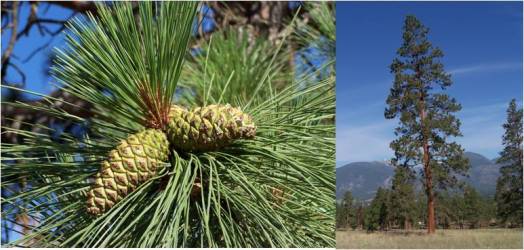We just wrapped up 2015 Oregon Arbor Week, so we thought we’d share a little bit about one of our favorite trees, the majestic Ponderosa pine. Central and Eastern Oregon just wouldn’t be the same without big Ponderosa pines.
History
Ponderosas are native to the Western United States and are found in 16 states and in British Columbia, Canada. The scientific name, Pinus Ponderosa, comes from the Latin word for pine, “pinus”, which means “pine”, and “pondus”, which means “heavy.”
Ponderosa pines have been a significant Northwest species for a long time. Native Americans ate Ponderosa seeds and the sweet, edible phloem in the inner bark. The Cheyenne Indians of Montana applied Ponderosa pine pitch inside whistles and flutes to improve the instruments’ tone. The Nez Pierce used the pitch as torch fuel and the Crow used pitch as glue. It was also used by some tribes to produce a blue dye.
Of course, Ponderosas have a huge historical significance here in Central Oregon, as they were the key timber species for the Brooks-Scanlon and Shevlin-Hixon mills in Bend in the early to mid 1900s.
In 1953, a select 145 poor pondos were cut down in Montana and transported to a Nevada nuclear testing site, where they were put into the ground and exposed to a nuclear blast. They wanted to see what would happen to the forest. Not surprisingly, the trees were partially burned and blown over.
Ecology
Ponderosas develop a strong taproot early on, and this helps them live in dry regions and survive through long periods of drought. Ponderosas are also fire resistant in several ways. They are somewhat self-pruning, meaning that as they grow, they drop their lower branches. This helps ward against low ladder fuel fires. They also develop a very thick bark – up to four inches thick on old trees. This too, helps them survive wildfires.
Ponderosas can live to be between 300 and 400 years old and can grow to an average height of 165 feet. The tallest recorded pine tree is a Ponderosa pine in the Siskiyou National Forest in Southern Oregon. It measures at 268 feet high!
If you stick your nose into the bark of a pondo, you’ll smell a distinct vanilla or butterscotch aroma.
Urban Environment
Read a little bit about how to keep Ponderosa pines healthy as a key urban forest species in Central Oregon.
Have a question about Ponderosa pines on your property? Give us a call! 541-480-4223
— Mike D.








